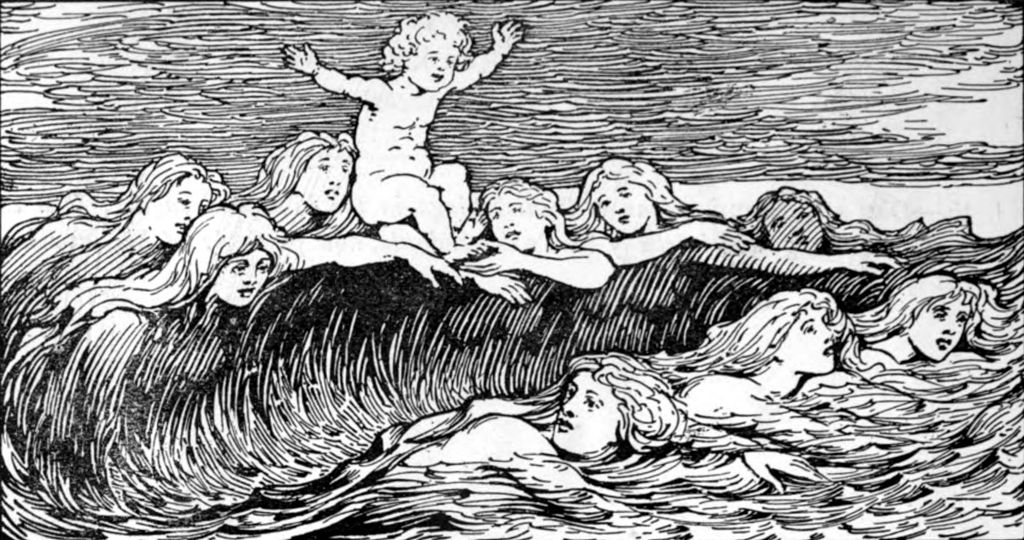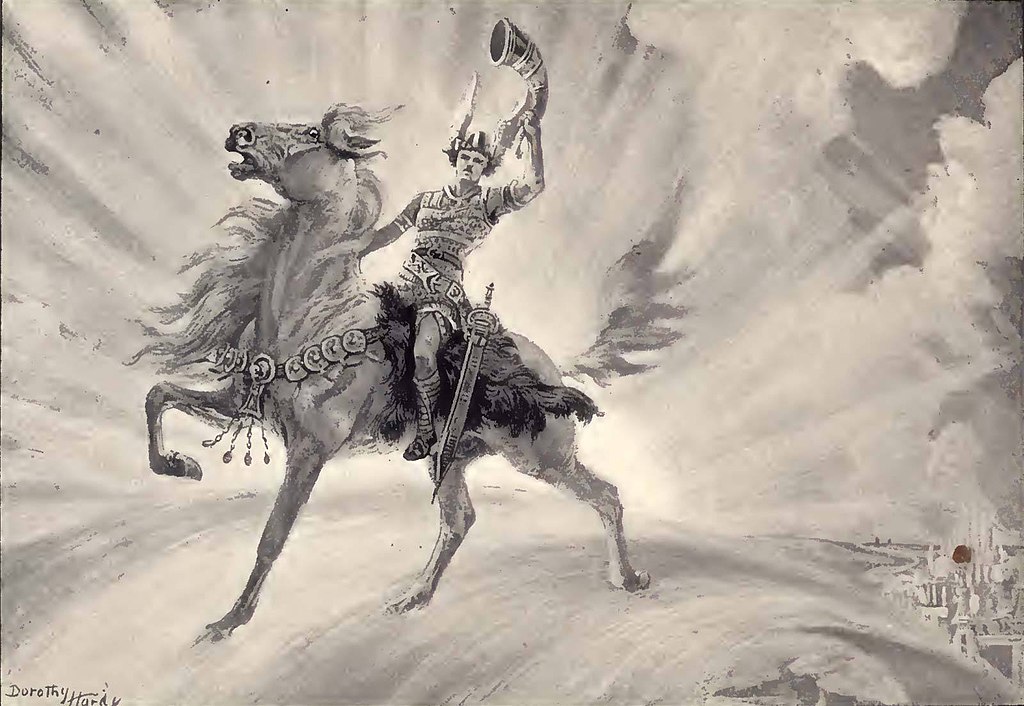Heimdall is the gatekeeper of the Bifrost (the rainbow bridge that linked Asgard and Midgard) and is considered the “Watchman of the Gods” in Norse mythology.
He had keen eyesight and hearing and could also see into the future. He is described as having teeth of gold and being “the whitest of gods.”
Heimdall lived in a hall in Asgard called Himinbjörg, used the resounding horn Gjallarhorn and rode a horse with a golden mane called Gulltoppr.
His parents are Odin, the Allfather, and the nine mothers of Heimdallr.
What Is Heimdall The God Of?
Heimdall (or Heimdallr in Old Norse) is called “The Shining God” because of his blond hair and fair complexion (ancient texts said he was the whitest skinned of the gods). However, it is not clear precisely which god Heimdall is, as it is not mentioned in any texts.
He did have supernatural powers as he is described as needing less sleep than a bird, and his hearing was so acute he could hear the growing of wool on sheep and grass in the field. He could see equally well in the dark as the light.
Heimdall could also shapeshift, which he demonstrated by transforming into a seal when clashing with Loki in the tale of the necklace Brisingamen.
Heimdall’s horn, Gjallarhorn, could be heard throughout heaven, earth, and other realms. The prophecies for Ragnarök, the Viking end of the world, predicted that Heimdall would sound Gjallarhorn to announce the arrival of the final battles.

What Is The Meaning Of Heimdall’s Name?
The exact etymology of “Heimdall” is unclear, although some believe that one of Freyja’s names, Mardöll, may be related.
Heimdall also has three other names: Gullintanni, Vindlér, and Hallinskiði. “Gullintanni” is “golden teeth” in English, while Vindlér means “protector against the wind or sea.”
Some scholars have theorized that Heimdall’s name is related to Yggdrasil, the world tree that supports the nine worlds of Norse cosmology.
Heimdall’s Relations To Other Norse Gods
Is Heimdall A Son Of Odin?
According to the Prose Edda, Heimdall is a son of Odin and belongs to the Æsir pantheon.
Heimdall and his Nine Mothers
The nine mothers of Heimdallr appear twice in the Prose Edda, in Gylfaginning, and in Skáldskaparmál. They are described as giantesses, meaning Heimdall could be a jötunn. The parents of the nine mothers are Ægir and Rán, gods associated with the sea.

Heimdallr’s mothers appear in chapter 25 of Gylfaginning. Hár (a common alias of Odin) tells King Gangleri that Heimdall has nine mothers and quotes Heimdall’s two lines from the lost poem Heimdalargaldr:
Offspring of nine mothers am I, of nine sisters am I the son.
The Elder Edda and Ancient Scandinavian Drama – Page 76
Chapter 16 of the 10th-century Skáldskaparmál by skald Úlfr Uggason tells us Heimdallr is the “son of eight mothers plus one, although a possible alternative translation is “son of one and eight waves.”
Völuspá Hin Skamma
The poem Völuspá Hin Skamma (The “Short” Voluspa) from the more extensive work Hyndluljóð contains stanzas that might be about Heimdall and his nine mothers.
One there was born in the bygone days,
Hyndluljóð – Sacred Texts
Of the race of the gods, and great was his might;
Nine giant women, at the world’s edge,
Once bore the man so might in arms.
Gjolp there bore him, Greip there bore him,
Eistla bore him, and Eyrgjafa,
Ulfrun bore him, and Angeyja,
Imth and Atla, and Jarnsaxa.
Strong was he made with the strength of the earth,
With the ice-cold sea and the blood of swine.
What Is Heimdall’s Role In Norse Mythology?
- He is the gatekeeper of the Bifrost, the rainbow bridge between Asgard and Midgard.
- He sounds the horn announcing the arrival of Ragnarök.
- During Ragnarök, he is prophecized to kill Loki after the mischief god escapes from a cave where he has been chained with a snake overhead that drips venom onto his face. Loki had prevented the return from Hel of the “gleaming god” Baldr and had been imprisoned as punishment by Baldr’s mother, Frigg.
What Is Heimdall’s Sword Called?
Heimdall’s sword is called “Hǫfuð” or the “Head of Man.”
Who Kills Heimdall Norse Mythology?
Loki kills Heimdall during Ragnarök.
Heimdall Attestations
Poetic Edda Attestations
Þrymskviða
The poem Þrymskviða tells the story of how Thor lost his hammer, Mjölnir, and the subsequent quest to retrieve it from Þrymr, king of the jötnar.
The trickster god Loki borrowed Freyja’s cloak of falcon feathers, so he could fly to Jotunnheim and locate the hammer. However, Þrymr would only give back the hammer in return for Freyja’s hand in marriage. This request angered Freyja – her rage shook the halls of the Æsir, and Brisingamen fell from her neck.
Heimdall suggested that Thor disguise himself as the goddess – earning the praise of the gods and comparisons with the wise Vanir. Thor agreed to this suggestion and borrowed Brísingamen as part of Freyja’s outfit when he traveled to the “wedding” in Jotunheim.
Völuspa
Völuspá mentions Heimdall is “the father of mankind.”
Prose Edda Attestations
Gylfaginning
Chapter 51 of Gylfaginning in the Prose Edda, compiled by the Icelandic politician, historian, and poet Snorri Sturluson, provides information about the preceding events of Ragnarök and some indications of the ensuing chaos.
Hár (one of Odin’s many aliases) talks about three major winter battles characterized by greed, causing families to fall apart and kill one another. Fimbulwinter (or Fimbulvetr), a period of three years of endless winter and hardly any sun, will follow these conflicts.
Heimdall will sound Gjallarhorn to announce the beginning of Ragnarök.
Húsdrápa
Loki and Heimdall clashed on a couple of occasions. The first was when Heimdall rescued Freyja’s necklace, Brisingamen, from Loki after a fight in which the two transformed into seals. They are prophecized to do battle during Ragnarök, finally killing each other.
The Prose Edda features a stanza from Húsdrápa by Úlfr Uggason:
Renowned defender of the powers’ way,
Prose Edda- Kurs It
kind of counsel,
competes with Farbauti’s oh-so-sly son at Singastein.
Son of eight mothers plus one,
might of mood,
is first to possess the beautiful sea kidney.
I announce it in strands of praise.
The “renowned defender” was Heimdall, and the “powers’ way” referred to the Bifrost. The sea kidney was the necklace called Brisingamen.
Rígsþula
Rígsþula (Old Norse: The Lay of Ríg), an Eddic poem, is about Ríg (or Rígr), an old, wise, and powerful Norse god, and how he creates man’s social classes. The poem is in four parts: The Birth of Thrall, The Birth of Churl, The Birth of Earl, and The Birth of King. The introduction mentions that Ríg is an alternative name to Heimdall.
The poem makes the origins of the four social classes sound like Ríg actually fathers them, using the word “birth” and “offspring”:
- Slaves and servants: the offspring of Thrall.
- Freemen and farmers: the offspring of Churl (or Karl).
- Nobles: the offspring of Earl (or Jarl).
- Royalty.
Heimdall – Norse Mythology Vs. Marvel Universe
Heimdall is black in the Thor movies of the Marvel world. Norse mythology described him as having blond hair, fair skin, and gold teeth.
The Titan Thanos kills Heimdall in the Marvel movie, but in Norse mythology, Loki kills him.
*Make sure to check my article on what the Marvel got right on Norse mythology.

